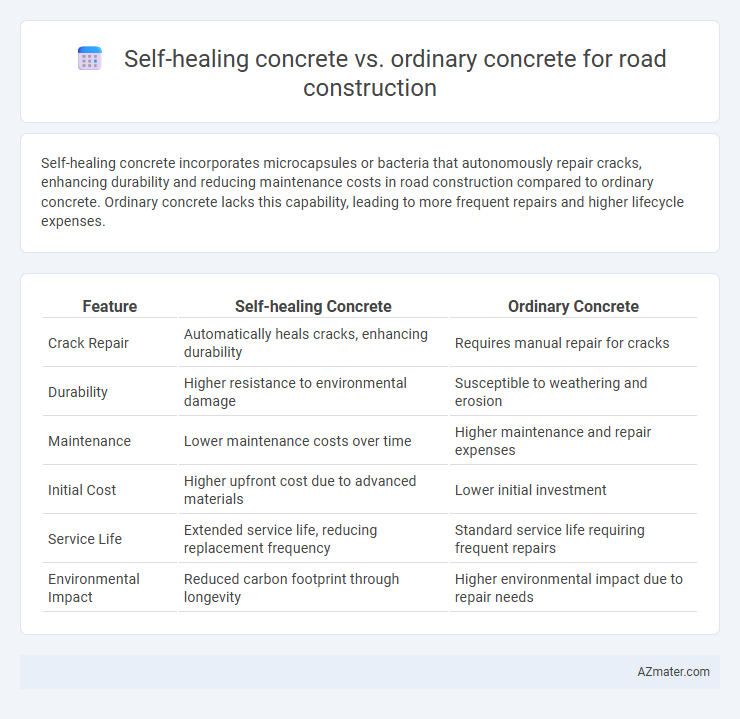Self-healing concrete incorporates microcapsules or bacteria that autonomously repair cracks, enhancing durability and reducing maintenance costs in road construction compared to ordinary concrete. Ordinary concrete lacks this capability, leading to more frequent repairs and higher lifecycle expenses.
Table of Comparison
| Feature | Self-healing Concrete | Ordinary Concrete |
|---|---|---|
| Crack Repair | Automatically heals cracks, enhancing durability | Requires manual repair for cracks |
| Durability | Higher resistance to environmental damage | Susceptible to weathering and erosion |
| Maintenance | Lower maintenance costs over time | Higher maintenance and repair expenses |
| Initial Cost | Higher upfront cost due to advanced materials | Lower initial investment |
| Service Life | Extended service life, reducing replacement frequency | Standard service life requiring frequent repairs |
| Environmental Impact | Reduced carbon footprint through longevity | Higher environmental impact due to repair needs |
Introduction to Road Construction Materials
Self-healing concrete incorporates microcapsules or bacteria that activate to repair cracks autonomously, enhancing durability and reducing maintenance costs in road construction. Ordinary concrete lacks this capability, often leading to premature deterioration through crack propagation and water ingress. Utilizing self-healing concrete improves long-term structural integrity and sustainability of roadways compared to traditional materials.
What is Ordinary Concrete?
Ordinary concrete is a widely used construction material composed of cement, water, aggregates, and sometimes admixtures, providing durability and strength for road construction. It lacks the ability to repair cracks autonomously, leading to maintenance challenges and reduced lifespan under heavy traffic and environmental stress. Its permeability allows water ingress, accelerating deterioration such as corrosion of reinforcement and freeze-thaw damage.
What is Self-Healing Concrete?
Self-healing concrete is an innovative material embedded with bacteria or capsules containing healing agents that activate upon crack formation, enabling automatic repair and extending the lifespan of road surfaces. Unlike ordinary concrete, which requires manual maintenance and is prone to deterioration from environmental stressors, self-healing concrete reduces maintenance costs and enhances durability by sealing micro-cracks before they propagate. This technology improves structural integrity and supports sustainable infrastructure development by minimizing concrete degradation on roads.
Composition and Technology Differences
Self-healing concrete incorporates microcapsules or bacteria that react with environmental moisture to autonomously repair cracks, whereas ordinary concrete relies solely on its initial mix of cement, aggregates, and water without self-repair capabilities. The technology behind self-healing concrete involves embedding healing agents such as calcium carbonate-producing bacteria or polymer capsules, which activate when cracks expose them to air or water. Ordinary concrete's composition focuses on optimization for strength and durability but lacks the advanced biological or chemical components that enable automatic crack healing in self-healing variants.
Durability and Longevity Comparison
Self-healing concrete significantly enhances road construction durability by autonomously repairing micro-cracks, which ordinary concrete cannot address, leading to reduced maintenance costs and extended service life. Its embedded healing agents activate when cracks occur, sealing them promptly and preventing water ingress and corrosive damage that typically degrade ordinary concrete. Consequently, roads built with self-healing concrete exhibit superior longevity and resilience under heavy traffic and environmental stress compared to those using traditional concrete.
Maintenance Requirements and Costs
Self-healing concrete significantly reduces maintenance requirements and long-term costs in road construction by autonomously repairing micro-cracks and preventing water ingress, thereby extending pavement lifespan. Ordinary concrete demands frequent inspections, crack sealing, and patch repairs that increase labor and material expenses over time. Investment in self-healing concrete technology offers cost efficiency through decreased repair frequency and enhanced durability against environmental stresses.
Environmental Impact and Sustainability
Self-healing concrete significantly reduces maintenance needs in road construction by autonomously repairing cracks, thereby extending pavement lifespan and minimizing resource consumption compared to ordinary concrete. Ordinary concrete often requires frequent repairs due to crack formation, leading to higher carbon emissions from construction activities and raw material extraction. Incorporating bacteria or encapsulated healing agents in self-healing concrete enhances sustainability by lowering CO2 emissions and reducing waste, making it a more environmentally friendly choice for infrastructure projects.
Performance in Harsh Weather Conditions
Self-healing concrete significantly outperforms ordinary concrete in harsh weather conditions due to its ability to autonomously repair micro-cracks, preventing water ingress and reducing freeze-thaw damage. This innovative material extends road durability by maintaining structural integrity and minimizing maintenance costs under extreme temperature fluctuations and heavy precipitation. In contrast, ordinary concrete deteriorates faster as cracks propagate, leading to increased vulnerability and frequent repairs in adverse environmental conditions.
Initial Investment vs. Long-Term Savings
Self-healing concrete involves higher initial investment costs compared to ordinary concrete due to advanced materials like microcapsules or bacteria for crack repair. Despite these upfront expenses, self-healing concrete significantly reduces long-term maintenance and repair costs by autonomously sealing micro-cracks, prolonging road durability. Over the lifespan of road infrastructure, this results in substantial savings and enhanced structural integrity, making it a cost-effective solution for sustainable road construction.
Future Prospects in Road Infrastructure
Self-healing concrete offers significant potential for enhancing road infrastructure longevity by autonomously repairing micro-cracks, reducing maintenance costs, and extending pavement life compared to ordinary concrete. Emerging technologies using bacteria or encapsulated healing agents in self-healing concrete demonstrate promising performance in increasing resistance to environmental stress and load-induced damage. Future road construction projects integrating self-healing materials could achieve sustainable infrastructure with improved durability and reduced lifecycle expenses.

Infographic: Self-healing concrete vs Ordinary concrete for Road construction
 azmater.com
azmater.com